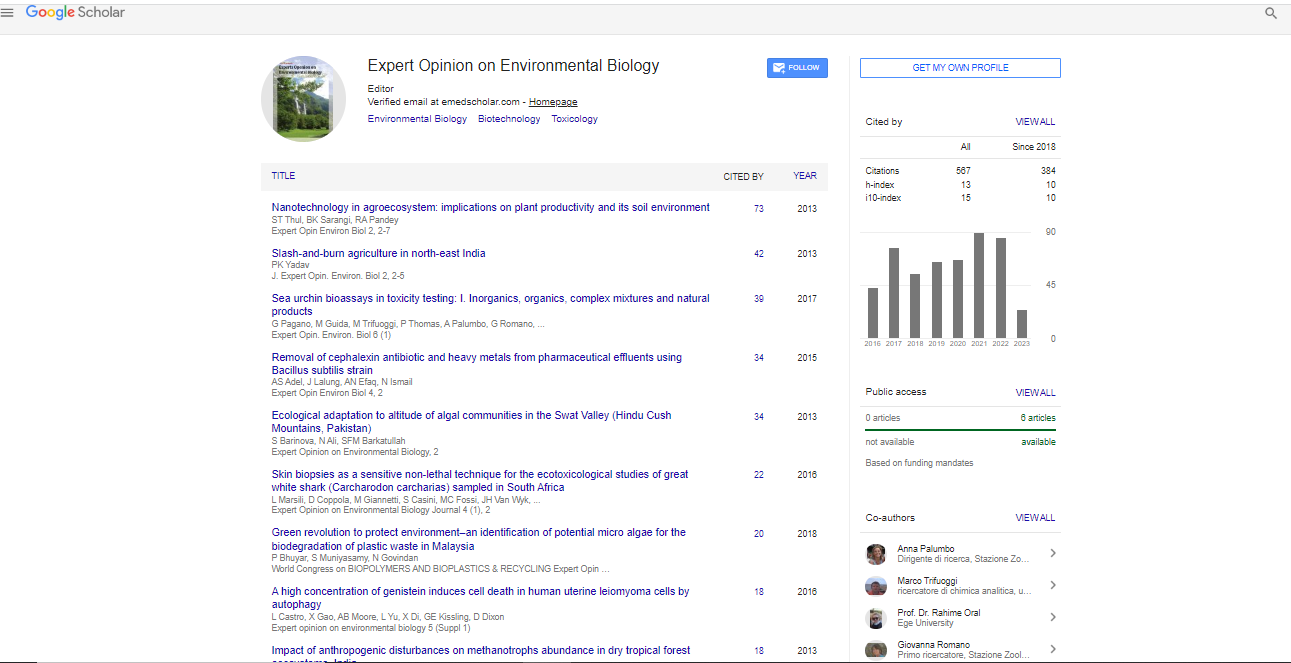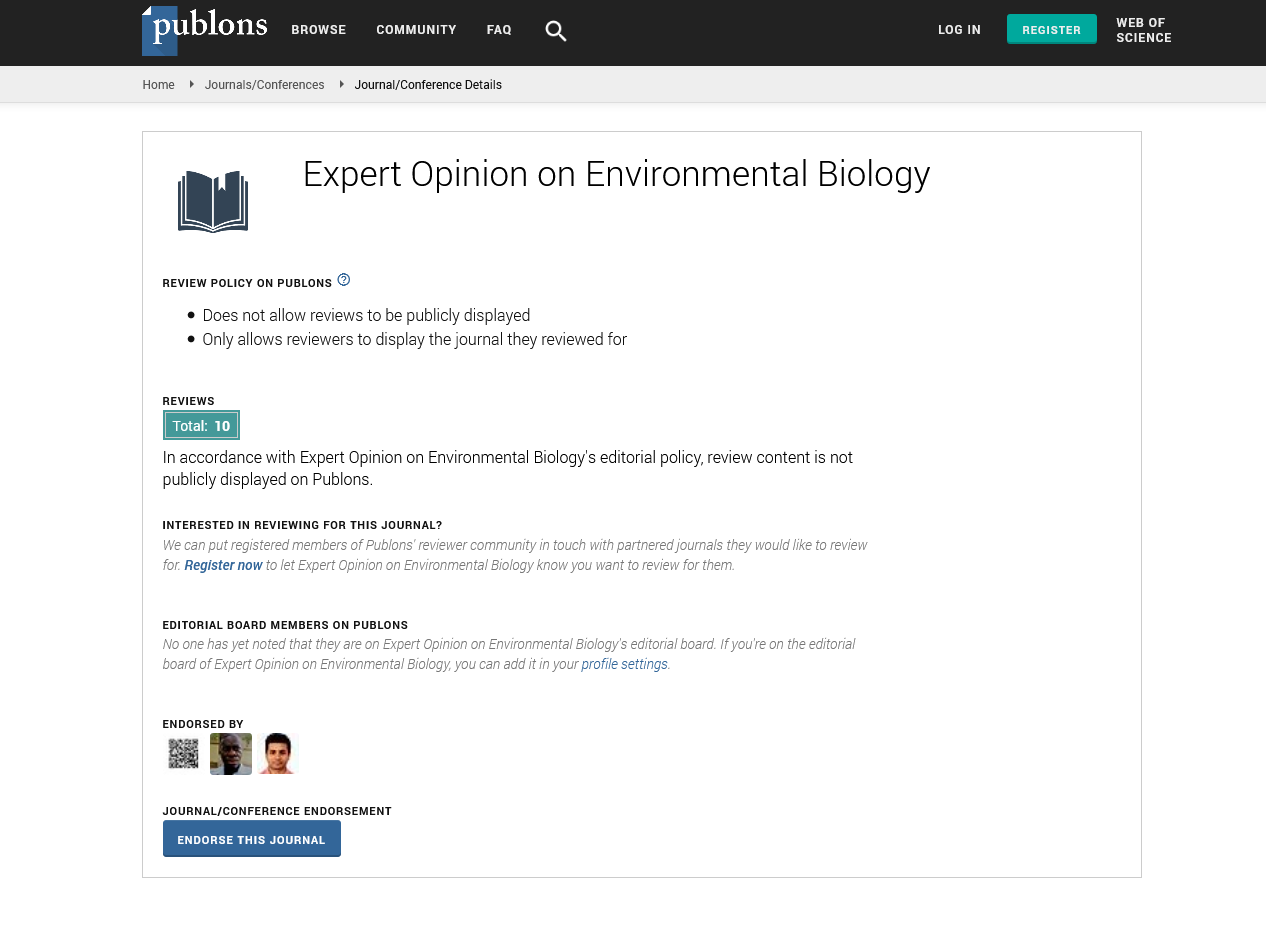Perspective, Expert Opin Environ Biol Vol: 14 Issue: 1
Biodiversity Loss and Its Ecological Consequences: A Global Perspective
Erik Karlsson*
Department of Environmental Science, Swedish University of Agricultural Sciences, Uppsala, Sweden
- *Corresponding Author:
- Erik Karlsson
Department of Environmental Science, Swedish University of Agricultural Sciences, Uppsala, Sweden
E-mail: erik_karlssonsus@gmail.com
Received: 01-Mar-2025, Manuscript No. EOEB-25-169975, Editor assigned: 03-Mar-2025, PreQC No. EOEB-25-169975(PQ), Reviewed: 17-Mar-2025, QC No. EOEB-25-169975, Revised: 21-Mar-2025, Manuscript No. EOEB-25-169975(R), Published: 28-Mar-2025, DOI: 10.4172/ 2325-9655.1000237
Citation: Erik K (2025) Advancing Cardiac Healing: The Role of Stem Cells in Regeneration and Future Prospects. J Regen Med 14:1.
Copyright: © 2025 Erik K. This is an open-access article distributed under the terms of the Creative Commons Attribution License, which permits unrestricted use, distribution and reproduction in any medium, provided the original author and source are credited.
Abstract
Biodiversity, encompassing the variety of life on Earth, is declining
at an unprecedented rate due to anthropogenic activities such as
habitat destruction, overexploitation, pollution, and climate change.
This loss undermines ecosystem stability, resilience, and the ability
to provide essential services, including food security, climate
regulation, and disease control. The present study reviews current
global trends in biodiversity decline, explores its primary drivers, and
examines the ecological consequences. Case studies demonstrate
the cascading effects of species extinction on ecosystem functions
and human well-being. The article emphasizes the urgent need for
conservation strategies, international cooperation, and sustainable
resource management to mitigate biodiversity loss and ensure the
continued functioning of natural systems.
Keywords: Biodiversity loss; Ecosystem stability; Extinction; Habitat destruction; Conservation strategies
Keywords
Biodiversity loss; Ecosystem stability; Extinction; Habitat destruction; Conservation strategies
Introduction
Biodiversity is the foundation of ecosystem health and human prosperity. However, scientific evidence reveals that we are in the midst of the sixth mass extinction, largely driven by human-induced pressures [1]. The rate of species loss far exceeds natural background rates, raising concerns about the future of ecological integrity. Understanding the scale, drivers, and consequences of biodiversity decline is essential for developing effective conservation interventions.
Description
Biodiversity loss manifests in multiple forms, including species extinction, genetic erosion, and ecosystem degradation. Habitat destruction, particularly deforestation, remains the leading cause, with tropical rainforests being among the most affected [2]. Overexploitation of species for food, medicine, and trade has further accelerated declines. Pollution, including chemical contaminants and plastic waste, disrupts reproductive cycles and food chains. Climate change exacerbates these threats by altering habitats and migration patterns.
The ecological consequences are profound. Loss of pollinators threatens agricultural productivity, while the disappearance of keystone species can trigger ecosystem collapse [3]. Additionally, biodiversity supports vital ecosystem services such as carbon sequestration, nutrient cycling, and water purification. The erosion of these services compromises both environmental sustainability and human health.
Results
Studies indicate that 1 million species are at risk of extinction within decades if current trends continue [4]. Ecosystems with reduced biodiversity show decreased resilience to disturbances, such as extreme weather events and disease outbreaks. The degradation of coral reefs, for example, leads to declines in fisheries and coastal protection, disproportionately affecting vulnerable communities. Furthermore, biodiversity loss has been linked to the increased emergence of zoonotic diseases, highlighting its role in global health security.
Discussion
Mitigating biodiversity loss requires a multi-faceted approach. Protected areas, while essential, must be complemented by sustainable land-use practices in surrounding landscapes. Community-based conservation has shown promise in balancing human needs with ecological protection [5]. International agreements like the Convention on Biological Diversity provide frameworks for cooperation, but implementation gaps persist. Economic incentives, such as payment for ecosystem services and biodiversity offsets, can promote conservation while supporting livelihoods.
Conclusion
Biodiversity loss is both an environmental and societal crisis with far-reaching implications. Reversing this trend demands urgent, coordinated action that addresses root causes while enhancing the adaptive capacity of ecosystems. Only through sustained conservation efforts, equitable resource use, and global collaboration can we secure the ecological foundation for future generations.
References
- Olsen LF, Issinger OG, Guerra B (2013) The Yin and Yang of redox regulation. Redox Rep 18: 245-252.
- Pernas L, Scorrano L (2016) Mito-morphosis: mitochondrial fusion, fission, and cristae remodeling as key mediators of cellular function. Annu Rev Physiol 78: 505-531.
- Alston CL, Rocha MC, Lax NZ, Turnbull DM, Taylor RW (2017) The genetics and pathology of mitochondrial disease. J Pathol 241: 236-250.
- Ong SB, Kalkhoran SB, Hernandez-Resendiz S, Samangouei P, Ong SG, et al. (2017) Mitochondrial-shaping proteins in cardiac health and disease â?? the long and the short of it!. Cardiovasc Drugs Ther 31: 87-107.
- Yu T, Robotham JL, Yoon Y (2006) Increased production of reactive oxygen species in hyperglycemic conditions requires dynamic change of mitochondrial morphology. Proc Natl Acad Sci U S A 103: 2653-2658.
 Spanish
Spanish  Chinese
Chinese  Russian
Russian  German
German  French
French  Japanese
Japanese  Portuguese
Portuguese  Hindi
Hindi 
